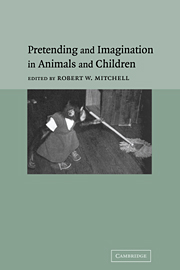Book contents
- Frontmatter
- Contents
- List of contributors
- Foreword by Sue Taylor Parker
- Preface and acknowledgments
- I Historical, developmental, and comparative overviews
- II Pretense and imagination in children
- 4 Language in pretense during the second year: what it can tell us about “pretending” in pretense and the “know-how” about the mind
- 5 A longitudinal and cross-sectional study of the emergence of the symbolic function in children between 15 and 19 months of age: pretend play, object permanence understanding, and self-recognition
- 6 Caregiver-child social pretend play: what transpires?
- 7 Just through the looking glass: children's understanding of pretense
- 8 Young children's understanding of pretense and other fictional mental states
- 9 Pretend play, metarepresentation and theory of mind
- 10 Replica toys, stories, and a functional theory of mind
- 11 Young children's animal-role pretend
- 12 Imaginary companions and elaborate fantasy in childhood: discontinuity with nonhuman animals
- III Pretense and imagination in primates
- IV Prospects
- References
- Author Index
- Subject Index
12 - Imaginary companions and elaborate fantasy in childhood: discontinuity with nonhuman animals
Published online by Cambridge University Press: 13 August 2009
- Frontmatter
- Contents
- List of contributors
- Foreword by Sue Taylor Parker
- Preface and acknowledgments
- I Historical, developmental, and comparative overviews
- II Pretense and imagination in children
- 4 Language in pretense during the second year: what it can tell us about “pretending” in pretense and the “know-how” about the mind
- 5 A longitudinal and cross-sectional study of the emergence of the symbolic function in children between 15 and 19 months of age: pretend play, object permanence understanding, and self-recognition
- 6 Caregiver-child social pretend play: what transpires?
- 7 Just through the looking glass: children's understanding of pretense
- 8 Young children's understanding of pretense and other fictional mental states
- 9 Pretend play, metarepresentation and theory of mind
- 10 Replica toys, stories, and a functional theory of mind
- 11 Young children's animal-role pretend
- 12 Imaginary companions and elaborate fantasy in childhood: discontinuity with nonhuman animals
- III Pretense and imagination in primates
- IV Prospects
- References
- Author Index
- Subject Index
Summary
There are a bewildering number of opinions about what constitutes pretend play and the extent that nonhuman animals are capable of it. Play fighting and object play in mammals and birds strike many observers as having the “acting as if” quality that we associate with pretending. Other researchers are more inclusive, claiming that “in all play, both animal and human, there is an element of ‘pretending’ ” (Aldis, 1975, p. 14). According to Darwin (1871/1896, p. 69; our italics), “even insects play together, as has been described by that excellent observer, P. Huber, who saw ants chasing and pretending to bite each other, like so many puppies.”
When acts of pretense are assumed to reflect a metacognitive understanding of behavior, claims about pretending in nonhuman animals (e.g., Bateson, 1955/1972) become more controversial (Mitchell, 1991a). For example, Rosenberg (1990) has argued that third-order reasoning about intentionality (i.e., animal A plays with the intention of animal B understanding that A's intention is nonserious) is beyond the intellectual capacity of any nonhuman species. However, according to Bekoff & Allen (1998) such demanding criteria might be said to preclude the possibility of pretending in young children as well! In fact, a growing number of developmentalists are claiming that too much cognitive credit had been attributed to child pretenders. In particular, Lillard (1993b; 1994; 1996; PIAC7) has shown that young children have difficulty when asked questions requiring them to reason about the representational aspects of pretending.
- Type
- Chapter
- Information
- Pretending and Imagination in Animals and Children , pp. 167 - 180Publisher: Cambridge University PressPrint publication year: 2002
- 9
- Cited by



